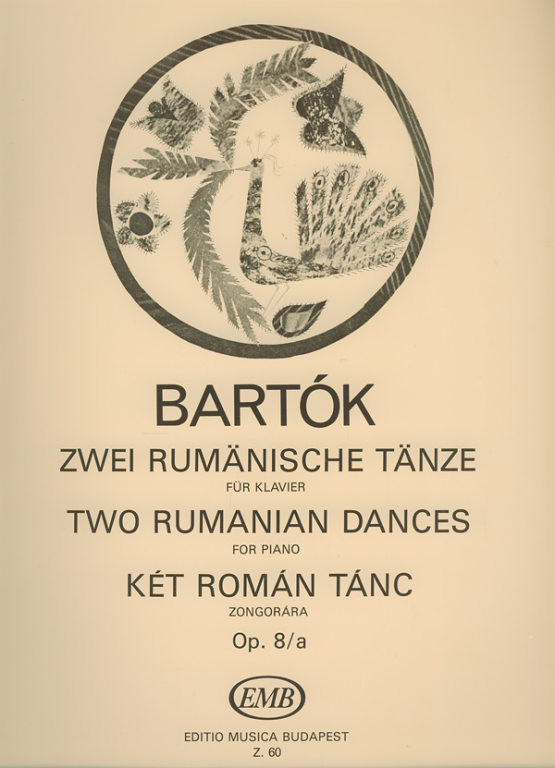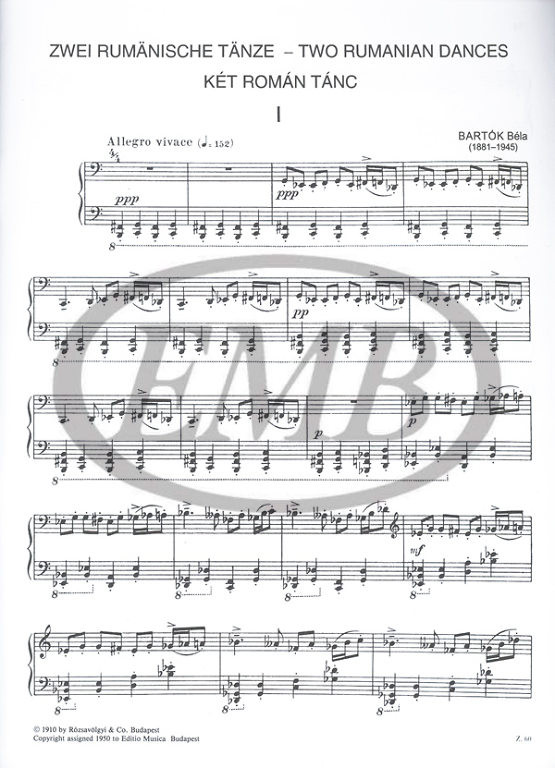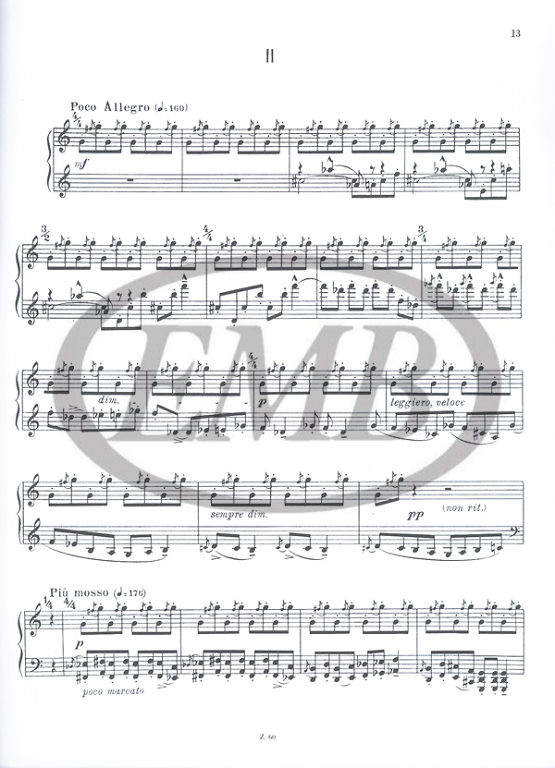Description
Bartók Béla: Two Rumanian Dances (1909–1910) | Sheet Music
Két román tánc – Editio Musica Budapest Zeneműkiadó (1951)
Product Details
- Item Number: 60
- ISMN: 9790080000601 / 979-0080000601
- Format: Paperback, Bach format (23 x 30,2 cm)
- Setting: Piano
- Period: 20th Century
- Language: Hungarian, English, German
- Length: 20 pages
- Weight: 0.091 kg
- Published: 1951
- Publisher: Editio Musica Budapest Zeneműkiadó
- Catalog Number: 60
- Made in: Hungary
Overview
English
Bartók Béla: Two Rumanian Dances (1909–1910) is an important edition that reflects Bartók’s early exploration of folk-inspired material. Composed during his first folk song collecting trip in July–August 1909 and finalized in March of the following year, these two dances were conceived not as direct arrangements of existing folk melodies but as original thematic creations that mirror the spirit of Romanian folk music. The first dance, immediately striking audiences with its distinctive, drum-like introduction and driving rhythmic energy, quickly garnered acclaim. Although the second dance is less popular in performance, it is considered compositionally more original, unfolding in a chain (füzérformában) where Bartók varies his material in a manner reminiscent of the “motive dances” of Romanian Transylvanian village musicians.
Hungarian
Bartók Béla: Két román tánc (1909–1910) mély betekintést nyújt a zeneszerző korai, népzenei ihletésű alkotásaiba. Az 1. táncot Bartók 1909 július–augusztusában, első erdélyi népzene-gyűjtőútja alatt írta, majd a következő év márciusában véglegesítette. A művek nem az ismert népdallamok egyszerű átiratai, hanem Bartók saját invenciós témáin alapulnak, melyekben a román népi zene hangulata jelenik meg. Az első tánc kifejezetten hatásos, különleges dobolás-szerű bevezetőjével és ösztönző ritmusaival azonnal lenyűgözte a közönséget. Bár a második tánc előadása kevésbé vált ismertté, zeneszerzőileg még eredetibb, mivel füzérszerűen vonultatja fel, variálva anyagát – ezzel is utalva a román vidéki zenészek, az úgynevezett „motívum táncok” játékára.
German
Bartók Béla: Zwei rumänische Tänze (1909–1910) bietet einen tiefen Einblick in Bartóks frühe, von Volksmusik inspirierten Kompositionen. Der erste Tanz wurde während seiner ersten Volksmusik-Sammelreise im Juli–August 1909 komponiert und der zweite im März des Folgejahres fertiggestellt. Anstatt bekannte Volksmelodien direkt zu übernehmen, entwickelt Bartók eigenständige Themen, die den Geist der rumänischen Volksmusik widerspiegeln. Der erste Tanz beeindruckt mit einem ungewöhnlichen, trommelschlagähnlichen Einstieg und einem treibenden Rhythmus, der sofort das Publikum in seinen Bann zieht. Der zweite Tanz, obwohl weniger populär in der Aufführung, gilt als formell noch origineller, da er das Material in einer Kettenform variiert – ganz im Sinne der von Bartók als „motivikus táncok“ bezeichneten Tänze, welche an das Spiel rumänischer transsilvanischer Dorfbands erinnern.
Product Features
-
Originality and Innovation:
- Bartók did not simply arrange existing folk tunes but composed original material inspired by the folk atmosphere.
- The first dance is notable for its powerful, rhythmic, drum-like introduction; the second dance unfolds in a chain-like (füzér) structure, highlighting Bartók’s innovative treatment of motivic material.
-
Impressive Performance Impact:
- The first dance made an immediate impact on audiences with its driving rhythms and pronounced percussion-like character.
- The second dance, though less frequently performed, showcases advanced compositional techniques and richer structural variation.
-
Authentic Presentation:
- This 20-page edition in the classic Bach format (23 x 30,2 cm) offers clear notation and faithful rendition of Bartók’s performance directions.
- Printed in Hungarian with parallel texts in English and German, it caters to a wide audience of performers and scholars.
-
Educational Value:
- As part of the rich tradition of Bartók’s engagement with folk material and his pioneering work in ethnomusicology, these dances serve as an excellent educational resource for music students.
- They illustrate the evolution from pure folk elements to a sophisticated, art-music language that influenced the trajectory of 20th-century classical music.
Long-tail keywords: Bartók Two Rumanian Dances sheet music, 1909-1910 Bartók composition, Romanian folk influences Bartók, early Bartók piano dances, Editio Musica Budapest Bartók, educational Bartók transcriptions, innovative folk-inspired dance, authentic 20th-century piano music
Interesting Facts
-
Historical Context:
Bartók began his systematic folk song collection in 1906. During his first Transylvanian trip in 1907, he recorded these three melodies at Gyergyótekerőpatak in Csík, forming the basis for both an accompanied version ("From Gyergyó") and a solo piano arrangement ("Three Hungarian Folksongs from Csík"). -
Audience Impact:
The immediate popularity of the first dance is attributed to Bartók’s unique performance style, characterized by an explosive, drum-like introduction and vigorous rhythm that captivated early audiences. -
Structural Innovation:
While the second dance may be less well-known, its structural originality—employing a chain form to vary its themes—demonstrates Bartók’s innovative approach in juxtaposing folk elements with contemporary techniques. Bartók himself noted that the themes, although not direct folk songs, were deeply reflective of the character of Romanian folk music. -
Scholarly Significance:
This work, which retains its original performance markings, stands as a testament to Bartók’s dual role as both a composer and an ethnomusicologist, bridging the gap between collected folk tradition and modern compositional practice.
Publishers
Published by Editio Musica Budapest Zeneműkiadó in 1951, this edition of Two Rumanian Dances is an indispensable resource for pianists, music scholars, and educators who wish to explore Bartók’s innovative integration of folk music traditions with modern classical techniques.
We value your feedback! Share your experience with this product to help others make informed decisions. Your review is important to us!
Hashtags
English:
#BartokFolkDances #TwoRumanianDances #EditioMusicaBudapest #20thCenturyMusic #FolkInspiredPiano #BartokComposition #InnovativeFolkMusic #PianoSheetMusic
Hungarian:
#BartókTáncok #KétRománTánc #EditioMusicaBudapest #XXszázadiZene #Népihangzás #BartókKompozíció #InnovatívNépzene #Zongorakotta
German:
#BartokTänze #ZweiRumänischeTänze #EditioMusicaBudapest #MusikDes20Jahrhunderts #VolksinspirierteKlaviermusik #BartokKomposition #InnovativeVolksmusik #Klavierpartitur


















